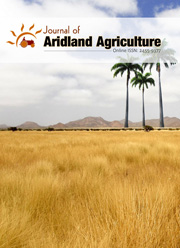Impact of climate classification on evapotranspiration variability in arid regions of Saudi Arabia
DOI:
https://doi.org/10.25081/jaa.2025.v11.9570Keywords:
Evapotranspiration, Climate Classification, TerraClimate, SARE Model, Saudi Arabia, Arid Regions, Water Management, Remote SensingAbstract
Water resource management in dry climates depends on an awareness of evapotranspiration variability. In this work, precipitation (Pr, mm/year) and air temperature (T °C) over Saudi Arabia (KSA) were extracted using long-term climate data (January 2000-December 2024) from the TerraClimate dataset. Three categories were used to classify both variables, therefore producing a new system of climate classification separating the Kingdom into nine different hydro-thermal groups. Using geo-spatial meteorological inputs, the Stand-Alone Remote Sensing Approach to Estimate Reference Evapotranspiration (SARE) model was employed to estimate reference evapotranspiration (ETo) for certain sites. Validation against the FAO-Penman-Monteith (FPM) model showed strong performance with correlation coefficients (r) ranging from 0.80 to 0.99 and Normalized Root Mean Square Error (NRMSE) values between 0.08 and 0.27 across the nine classes. Whereas relative humidity revealed a strong inverse association (r as low as -0.96), Tmax and solar radiation were found as main causes of ETo fluctuation (r up to 0.98 and 0.96, respectively). Especially in cooler, humid areas, wind speed showed secondary influence. These results underline the need of climate-specific evapotranspiration models for arid areas, where customized strategies are essential to maximize water consumption and guarantee sustainable resource management.
Downloads
References
Abdelraouf, R. E., El-Shawadfy, M. A., Bakry, A. B., Abdelaal, H. K., El-Shirbeny, M. A., Ragab, R., & Belopukhov, S. L. (2024). Estimating ETO and scheduling crop irrigation using Blaney-Criddle equation when only air-temperature data are available and solving the issue of missing meteorological data in Egypt. BIO Web of Conferences (Vol. 82, Article 02020). EDP Sciences. https://doi.org/10.1051/bioconf/20248202020
Afify, N. M., El-Shirbeny, M. A., El-Wesemy, A. F., & Nabil, M. (2023). Analyzing satellite data time-series for agricultural expansion and its water consumption in an arid region: A case study of the Farafra Oasis in Egypt’s Western Desert. Euro-Mediterranean Journal for Environmental Integration, 8(1), 129-142. https://doi.org/10.1007/s41207-022-00340-4
Ajjur, S. B., & Al-Ghamdi, S. G. (2021). Evapotranspiration and water availability response to climate change in the Middle East and North Africa. Climatic Change, 166(3), 28. https://doi.org/10.1007/s10584-021-03122-z
Alhathloul, S. H., Khan, A. A., & Mishra, A. K. (2024). Temporal variability of temperature, precipitation, drought, and their potential influence on horizontal visibility over Saudi Arabia. Theoretical and Applied Climatology, 155(12), 4621-4639. https://doi.org/10.1007/s00704-024-04906-w
Allen, R. G., Pereira, L. S., Raes, D., & Smith, M. (1998). Crop Evapotranspiration-Guidelines for Computing Crop Water Requirements-FAO Irrigation and Drainage Paper 56. Rome, Italy: FAO.
Al-Wabel, M. I., Sallam, A., Ahmad, M., Elanazi, K., & Usman, A. R. A. (2020). Extent of climate change in Saudi Arabia and its impacts on agriculture: A case study from Qassim Region. In S. Fahad, J. Saud, C. Wu, D. Adnan, M. A. Turan & M. Ul-Allah (Eds.), Environment, Climate, Plant and Vegetation Growth (pp. 557-572) Cham: Springer. https://doi.org/10.1007/978-3-030-49732-3_25
Bindajam, A. A., Mallick, J., AlQadhi, S., Singh, C. K., & Hang, H. T. (2020). Impacts of vegetation and topography on land surface temperature variability over the semi-arid mountain cities of Saudi Arabia. Atmosphere, 11(7), 762. https://doi.org/10.3390/atmos11070762
Derardja, B., Khadra, R., Abdelmoneim, A. A. A., El-Shirbeny, M. A., Valsamidis, T., De Pasquale, V., & Deflorio, A. M. (2024). Advancements in remote sensing for evapotranspiration estimation: A comprehensive review of temperature-based models. Remote Sensing, 16(11), 1927. https://doi.org/10.3390/rs16111927
Eid, A. R., Fathy, M., El-Sayed, A., Hafez, M., El-Shirbeny, M. A., Reda, A. M., Mady, A. Y., Ramadan, A., Fathy, M., El-Sayed, A., Hafez, M., Ahmed, M., El-Shirbeny, M. A., & Reda, A. M. (2023). Validation of SALTMAD model for simulating soil moisture and faba bean productivity under deficit irrigation and integrated fertilization in the semi-arid regions. Soil & Environment, 42(2), 111-129. https://doi.org/10.25252/SE/2023/242926
Elnesr, M., & Alazba, A. (2013). Effect of climate change on spatiotemporal variability and trends of evapotranspiration, and its impact on water resources management in the Kingdom of Saudi Arabia. In B. R. Singh (Ed.), Climate Change - Realities, Impacts Over Ice Cap, Sea Level and Risks (pp. 273-296) USA: InTech. https://doi.org/10.5772/54832
ElNesr, M., Alazba, A., & Abu-Zreig, M. (2010). Spatio-temporal variability of evapotranspiration over the Kingdom of Saudi Arabia. Applied Engineering in Agriculture, 26(5), 833-842. https://doi.org/10.13031/2013.34944
El-Rawy, M., Batelaan, O., Al-Arifi, N., Alotaibi, A., Abdalla, F., & Gabr, M. E. (2023). Climate change impacts on water resources in arid and semi-arid regions: A case study in Saudi Arabia. Water, 15(3), 606. https://doi.org/10.3390/w15030606
El-Shirbeny, M. A., & Abdellatif, B. (2017). Reference evapotranspiration borders maps of Egypt based on kriging spatial statistics method. International Journal of GEOMATE, 13(37), 1-8. https://doi.org/10.21660/2017.37.63048
El-Shirbeny, M. A., & Abutaleb, K. A. (2018). Monitoring of water-level fluctuation of Lake Nasser using altimetry satellite data. Earth Systems and Environment, 2(4), 367-375. https://doi.org/10.1007/s41748-018-0069-5
El-Shirbeny, M. A., & Biradar, C. (2024). Advances in earth observation and artificial intelligence in monitoring vegetation dynamics of dryland agroecosystems. In A. Srivastava, P. K. Aggarwal & P. D. Singh (Eds.), Vegetation Dynamics and Crop Stress (pp. 1-19) Cambridge, Massachusetts: Academic Press. https://doi.org/10.1016/B978-0-323-95616-1.00001-8
El-Shirbeny, M. A., & Orlandini, S. (2023). Monitoring of crop water consumption changing based on remotely sensed data and techniques in North Sinai, Egypt. Journal of Aridland Agriculture, 9, 1-8. https://doi.org/10.25081/jaa.2023.v9.7464
El-Shirbeny, M. A., & Saleh, S. M. (2021). Actual evapotranspiration evaluation based on multi-sensed data. Journal of Aridland Agriculture, 7, 95-102. https://doi.org/10.25081/jaa.2021.v7.7087
El-Shirbeny, M. A., Abdellatif, B., Ali, A. E. M., & Saleh, N. H. (2016). Evaluation of Hargreaves based on remote sensing method to estimate potential crop evapotranspiration. International Journal of GEOMATE, 11(23), 2143-2149. https://doi.org/10.21660/2016.23.1122
El-Shirbeny, M. A., Aboelghar, M. A., Arafat, S. M., & El-Gindy, A. M. (2014). Assessment of the mutual impact between climate and vegetation cover using NOAA-AVHRR and Landsat data in Egypt. Arabian Journal of Geosciences, 7(4), 1287-1296. https://doi.org/10.1007/s12517-012-0791-3
El-Shirbeny, M. A., Ali, A. M., Khdery, G. A., Saleh, N. H., Afify, N. M., Badr, M. A., & Bauomy, E. M. (2021a). Monitoring agricultural water in the desert environment of New Valley Governorate for sustainable agricultural development: A case study of Kharga. Euro-Mediterranean Journal for Environmental Integration, 6, 56. https://doi.org/10.1007/s41207-021-00256-5
El-Shirbeny, M. A., Ali, A. M., Savin, I., Poddubskiy, A., & Dokukin, P. (2021b). Agricultural water monitoring for water management under pivot irrigation system using spatial techniques. Earth Systems and Environment, 5, 341-351. https://doi.org/10.1007/s41748-020-00164-8
El-Shirbeny, M. A., Alsersy, M. A., Saleh, N. H., & Abu-Taleb, K. A. (2015). Changes in irrigation water consumption in the Nile Delta of Egypt assessed by remote sensing. Arabian Journal of Geosciences, 8, 10509-10519. https://doi.org/10.1007/s12517-015-2005-2
El-Shirbeny, M. A., Biradar, C., Amer, K., & Paul, S. (2022). Evapotranspiration and vegetation cover classifications maps based on cloud computing at the Arab countries scale. Earth Systems and Environment, 6(4), 837-849. https://doi.org/10.1007/s41748-022-00320-2
El-Shirbeny, M. A., Hendawy, E. A., Baioumy, E. M., Elbana, M., Gamal, R., & Abou-Hadid, A. F. (2025). Cloud computing random forest classification for major agricultural crops in the Nile Delta of Egypt. Euro-Mediterranean Journal for Environmental Integration. https://doi.org/10.1007/s41207-025-00899-8
El-Shirbeny, M. A., Mohamed, E. S., & Negm, A. (2019). Estimation of crops water consumptions using remote sensing with case studies from Egypt. In A. Negm (Ed.), Conventional Water Resources and Agriculture in Egypt (pp. 451-469) Cham, Switzerland: Springer International Publishing. https://doi.org/10.1007/698_2018_305
Gamal, R., El-Shirbeny, M., Abou-Hadid, A., Swelam, A., El-Gindy, A. G., Arafa, Y., & Nangia, V. (2022). Identification and quantification of actual evapotranspiration using integrated satellite data for sustainable water management in dry areas. Agronomy, 12(9), 2143. https://doi.org/10.3390/agronomy12092143
Haq, M. A., & Khan, M. Y. A. (2022). Crop water requirements with changing climate in an arid region of Saudi Arabia. Sustainability, 14(20), 13554. https://doi.org/10.3390/su142013554
IPCC. (2021). AR6 Climate Change 2021: The Physical Science Basis. Intergovernmental Panel on Climate Change. https://www.ipcc.ch/report/ar6/wg1/
Komurcu, M., Schlosser, C. A., Alshehri, I., Alshahrani, T., Alhayaza, W., AlSaati, A., & Strzepek, K. (2020). Mid-century changes in the mean and extreme climate in the Kingdom of Saudi Arabia and implications for water harvesting and climate adaptation. Atmosphere, 11(10), 1068. https://doi.org/10.3390/atmos11101068
Köppen, W. (1936). Das geographische System der Klimate. Gebruder Borntrager, 1, 1-44.
Mahmoud, S. H., Gan, T. Y., & Zhu, D. Z. (2023). Impacts of climate change and climate variability on water resources and drought in an arid region and possible resiliency and adaptation measures against climate warming. Climate Dynamics, 61, 4079-4105. https://doi.org/10.1007/s00382-023-06795-7
Monteith, J. L. (1965). Evaporation and environment. Symposia of the Society for Experimental Biology, 19, 205-234.
Moriasi, D., Arnold, J., Van Liew, M., Bingner, R., Harmel, R., & Veith, T. (2007). Model evaluation guidelines for systematic quantification of accuracy in watershed simulations. Transactions of the ASABE, 50(3), 885-900. https://doi.org/10.13031/2013.23153
Peel, M. C., Finlayson, B. L., & McMahon, T. A. (2007). Updated world map of the Köppen-Geiger climate classification. Hydrology and Earth System Sciences, 11(5), 1633-1644. https://doi.org/10.5194/hess-11-1633-2007
Penman, H. L. (1948). Natural evaporation from open water, bare soil and grass. Proceedings of the Royal Society A, 193, 120-146.
Tolba, R. A., El-Shirbeny, M. A., Abou-Shleel, S. M., & El-Mohandes, M. A. (2020). Rice acreage delineation in the Nile Delta based on thermal signature. Earth Systems and Environment, 4, 287-296. https://doi.org/10.1007/s41748-019-00132-x
Willmott, C. J. (1982) Some Comments on the Evaluation of Model Performance. Bulletin of the American Meteorological Society, 63, 1309-1313. https://doi.org/10.1175/1520-0477(1982)063%3C1309:SCOTEO%3E2.0.CO;2
Youssef, M. A., Peters, R. T., El-Shirbeny, M., Abd-ElGawad, A. M., Rashad, Y. M., Hafez, M., & Arafa, Y. (2024). Enhancing irrigation water management based on ETo prediction using machine learning to mitigate climate change. Cogent Food & Agriculture, 10(1), 2348697. https://doi.org/10.1080/23311932.2024.2348697
Published
How to Cite
Issue
Section
Copyright (c) 2025 Mohammed El-Shirbeny, Samir Mahmoud Saleh, Essam Baioumy, Mahmoud Badr, Adel Selim, Ehab Hendawy, R. E. Abdelraouf

This work is licensed under a Creative Commons Attribution-NonCommercial 3.0 Unported License.





 .
.